
RIBA President’s Medals Student Awards 2009
A project envisaging coastal defense towers that can be used as book depositories will be announced as one of the winners of the RIBA President's Medals Student Awards at a ceremony in London tonight.
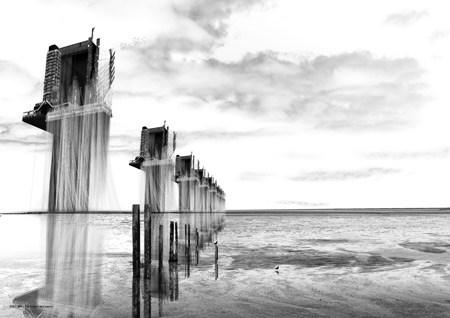
Above: A Defensive Architecture by Nicholas Szczepaniak
Nicholas Szczepaniak from the University of Westminster will receive the Silver Medal for his project (above and below) called A Defensive Architecture, envisaging a series of coastal defence towers that can also be used as book depositories.

Above: A Defensive Architecture by Nicholas Szczepaniak
Wen Ying Teh from the Architectural Association has won the Bronze Medal for her project An Augmented Ecology of Wildlife and Industry (top image), which explores combining industry and wildlife conservation in the Glapagos Islands to maximise the locality's resources. The resulting design integrates a salt farm and a flamingo sanctuary.
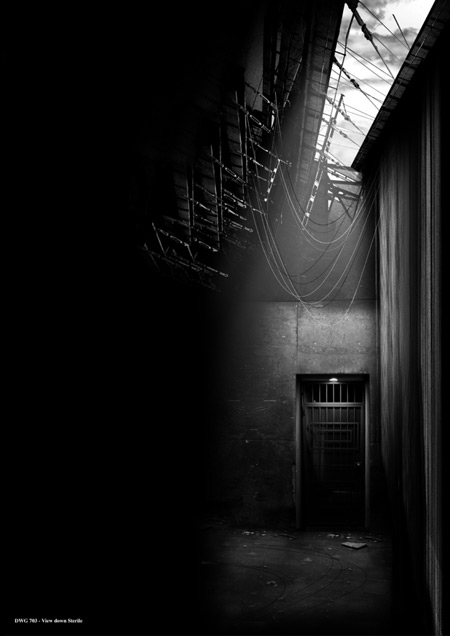
Above: A Defensive Architecture by Nicholas Szczepaniak
The Dissertation Medal will be awarded to Rebecca Gregory from the University of Westminster for her dissertation entitled The Art of Skew Bridges: The Technique and its History Explored.
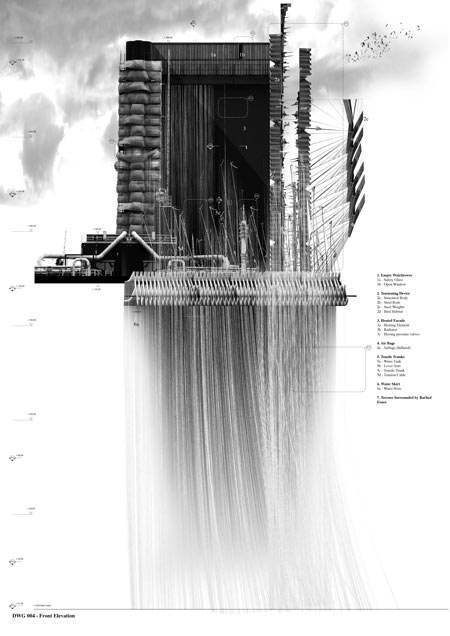
Above: A Defensive Architecture by Nicholas Szczepaniak. Click for larger image
All shortlisted projects will be on display at the RIBA in London until the end of January 2010.
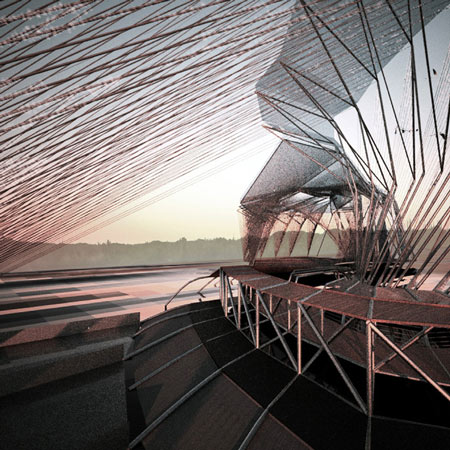
Above and top: An Augmented Ecology of Wildlife and Industry by Wen Ying Teh
Here is a selection of shortlisted projects with captions provided by the students.
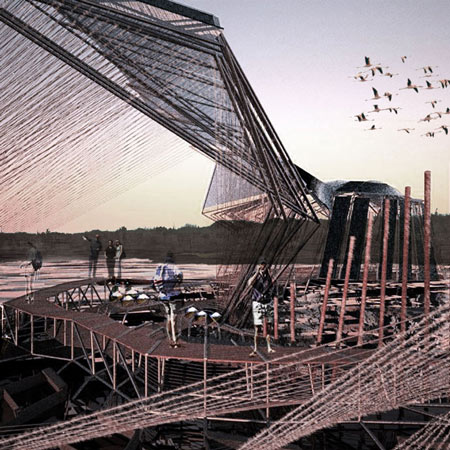
Above: An Augmented Ecology of Wildlife and Industry by Wen Ying Teh
All entries can be seen on the President’s Medals website.
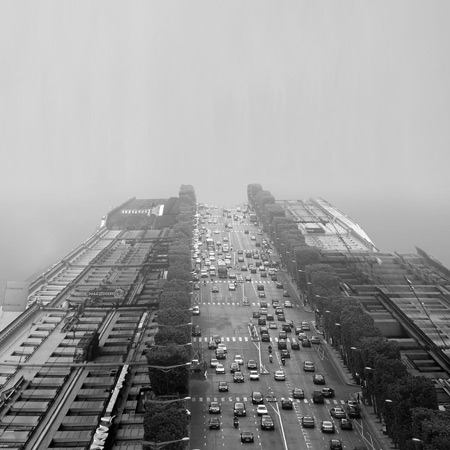
New Malacovia by Pascal Bronner (above and below)
This project is intended to conjure unexpected readings of the built environment in the future if we don't take more drastic steps to deal with climate change. If the planet is left to change as it is currently doing so it is easy to imagine that soon fossil fuels will have become depleted, and vast amounts of land will have been lost due to rising water levels or arid climates.
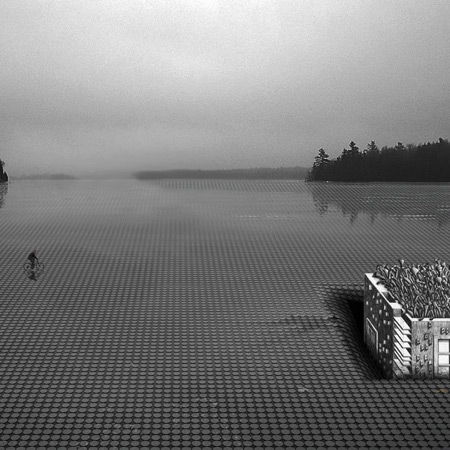
Above: New Malacovia by Pascal Bronner
Inevitably this will have an undesired effect on social order and the built environment. Resources will become rationed, and public space will become further militarized in order to maintain social order. This will enhance an already emerging sense of inertia across public space. The idea of this project is to comment on and alert us to these problems.
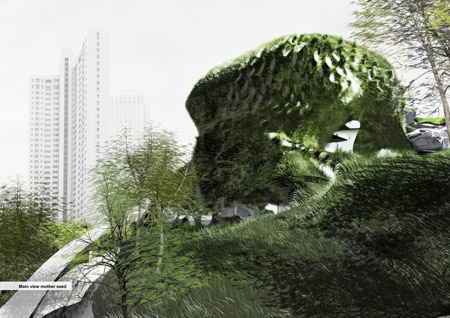
Biometamorphic Architecture - Organ Transplantation Clinic and Laboratory by Jonathan Alotto and Jaenes Bong (above and below)
In the 21-century, Bio-medical development of organ transplantation has opened up the possibility for patients to replace their dysfunctional body parts from donated individuals. According to global statistic, due to the lack of organs supply, an increasing number of patients are waiting for life saving treatments as many are suffering from long term illness.
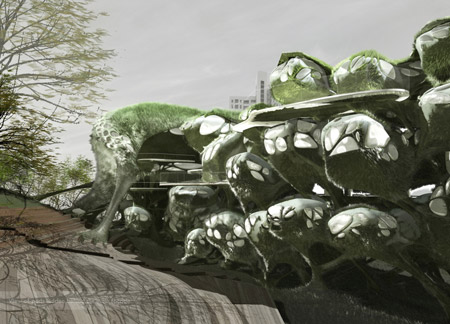
Above: Biometamorphic Architecture by Jonathan Alotto and Jaenes Bong
The project is sited in Hong Kong, a city known for its world class reputation on trading industry since the British Colonization. The architectural investigation explores the notion of trade in bio-medical transplantation. This controversial design speculates a new mode of activities and architectural model by bringing a place for private [Organ] trading.
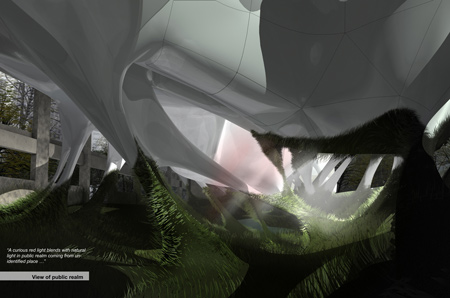
Above: Biometamorphic Architecture by Jonathan Alotto and Jaenes Bong
Inspired by Hieronymus Bosch's painting 'The Garden of Earthly Delights', the hell’s scenery abstracted the metamorphic relationship between human and nature. It leads us to a poetic narrative which we wanted to create a proposal that reflects Hong Kong’s hidden natural beauty and its Chinese spiritual mythology. The design methodology convoluted the boundaries between actual and digital explorations in a series of drawings and models which investigated the visual perception on building typology and spatial formation upon the quality of mysterious landscapes and ecological design.
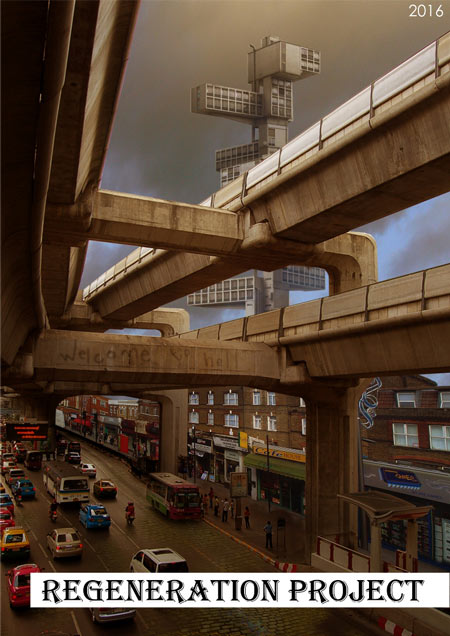
Workhouse of the Infrastructural (Counter) Reformation by Jordan Hodgson (above and below)
By 2032 the chaotic urban conditions that once helped define Elephant and Castle have given rise to a cripplingly disenfranchised underclass.
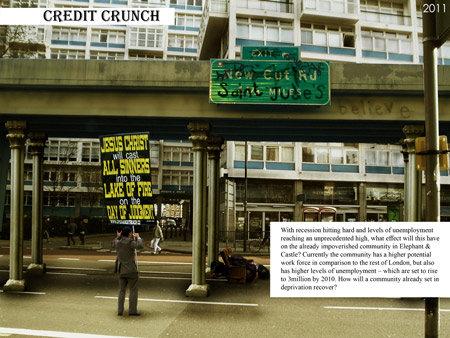
Above: Workhouse of the Infrastructural (Counter) Reformation by Jordan Hodgson
In this bleak landscape of proletariat discontent, might the British government revert back to Victorian modes of jurisdiction, whilst simultaneously providing an architectural placebo to soothe a nervous population?
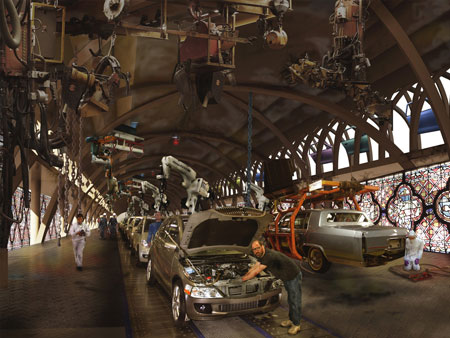
Above: Workhouse of the Infrastructural (Counter) Reformation by Jordan Hodgson
Unprecedented levels of unemployment generated by the crash of 2008, combined with a paralysis of social mobility triggers the reinauguration of the once potent Workhouse typology.
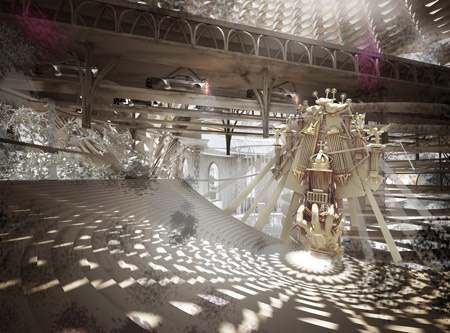
Above: Workhouse of the Infrastructural (Counter) Reformation by Jordan Hodgson
A re-branded Victorian-style workhouse, reminiscent of a lost empire, provides a sanctuary for adrift individuals and the crucial workforce required for a British industrial renaissance. The lost industries of the golden age are reawakened from decades of slumber and manifested in a glorified cathedral to the plebeians of Elephant and Castle.
Here's a press release from the RIBA:
--
RIBA President’s Medals Student Awards 2009 winners announced
The winners of the RIBA President’s Medals Student Awards 2009 in association with Atkins will be announced at a ceremony at the Royal Institute of British Architects (RIBA) tonight. These prestigious awards promote excellence in the study of architecture, rewarding talent and encouraging architectural debate world-wide.
Nicholas Szczepaniak, from the University of Westminster, won the Silver Medal for his project “A Defensive Architecture” and Wen Ying Teh from the Architectural Association won the Bronze Medal for her project “An Augmented Ecology of Wildlife and Industry”. Rebecca Gregory from the University of Westminster won the Dissertation Medal for her work “The Art of Skew Bridges: The Technique and its History Explored”.
The main President’s Medals are: the Bronze Medal (awarded to the best Part 1 design project), the Silver Medal (for the best Part 2 design project) and the Dissertation Medal, which is awarded for the best exploration of different subjects, methodologies and presentations.
A record 250 Schools of architecture from 50 countries were invited to nominate two of their best student design projects at Part 1 (first degree), two at Part 2 (second degree) and one dissertation. The awards achieved the highest number of entries ever in 2009, with over 70 schools of architecture from 25 countries accepting the invitation to submit entries.
Ruth Reed, President of the RIBA, said:
“The annual celebration of the President’s Medals reward the outstanding young talent in schools of architecture in the UK and across the world, and this year is certainly no exception. Education is an area of great importance to me, and I warmly congratulate this year’s winners for their excellent work.”
Philip Watson, Head of Education for Atkins, said:
“We are proud once again to sponsor the President’s Medals. It is incredibly invigorating to see so many fresh, new ideas coming through from the next generation of architects. This is a way for us to fly the flag for our profession at a time when major streams of publicly funded work, such as new schools programmes, are giving us an opportunity to show off the importance of good design in shaping both people and behaviours."
A number of other awards were also presented at the ceremony, including Commendations in the three main categories.
Commendations for Part 1 were awarded to the projects “Pygmalion’s Cathedral of Cosmetic Surgery” by Biten Patel of the University of Brighton, and “The Secret Policemen’s Saloon” by Robert Taylor of the University of Sheffield. Marcus Todd from the University of Nottingham was also awarded a Commendation for the Project “Wide Open / Land[S] In Lands”.
Commendations for Part 2 were awarded to Selvei Al-Assadi (London South Bank University) for the project “Media City – Vertical Discovery (MC-VD)” and to Stephen Townsend (University of Nottingham) for “Digital Intimacy”. The judges awarded a High Commendation at Part 2 to Paul Durcan (from University College Dublin, Ireland) for the project “(Re)Making_City”.
Commendations in the Dissertation category were awarded to Giles Smith (University of Cambridge) for “Living Infrastructure: The Vital Occupation of Non-Places Under London’s Westway”, Adam Towle (University of Sheffield) for “Negotiating the Spectacle: Projecting Fact, Fantasy and Fiction in Dubai”, and to Jamie Williamson (Oxford Brookes University) for “[Here Be Monsters].”
The Skidmore Owings and Merrill Foundation awarded two travelling fellowships of £1,250 each, to Robert Taylor from the University of Sheffield for “The Secret Policemen’s Saloon” for Part 1, and to Nicholas Szczepaniak, from the University of Westminster for the project “A Defensive Architecture” for Part 2.
The Serjeant Award for Excellence in Drawing was awarded to Anam Hasan, from the University of Greenwich, for the project “Desert(Ed) Hotel” at Part 1, and to Pascal Bronner, from the Bartlett School of Architecture, for “New Malacovia” at Part 2.
The student medallists receive £1,250 each and the commendation winners receive £500 each. The Serjeant Award winners receive £250 in book vouchers to use at RIBA Bookshops.
Chaired by Oliver Richards (ORMS and RIBA Vice-President for Education), the judging panel for the design projects included Willem Jan Neutelings (Neutelings Riedijk Architects, Rotterdam), Eric Parry (Eric Parry Architects, London), and Nanako Umemoto (Reiser + Umemoto, New York). The jury for the Dissertation Medal, chaired by Professor Peter Blundell Jones (University of Sheffield), comprised Dr Tim Martin (De Montfort University), Professor Alan Powers (University of Greenwich) and Dr Alexandra Stara (Kingston University).
The public exhibition of winning work is on display at the RIBA, London W1, until the end of January 2010.
Atkins is the principal sponsor of the President’s Medals which are also sponsored by the Institute of Materials, Minerals and Mining (IOM3), Service Point, the SOM Foundation and Ibstock Brick, while the Architects’ Journal is media partner. Tiger Beer and Absolut Vodka were ceremony sponsors.